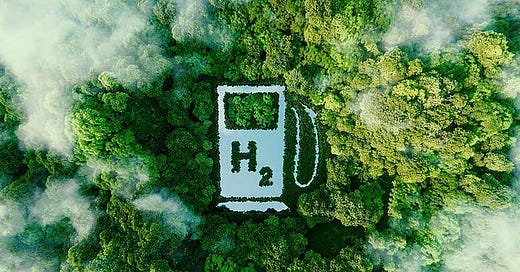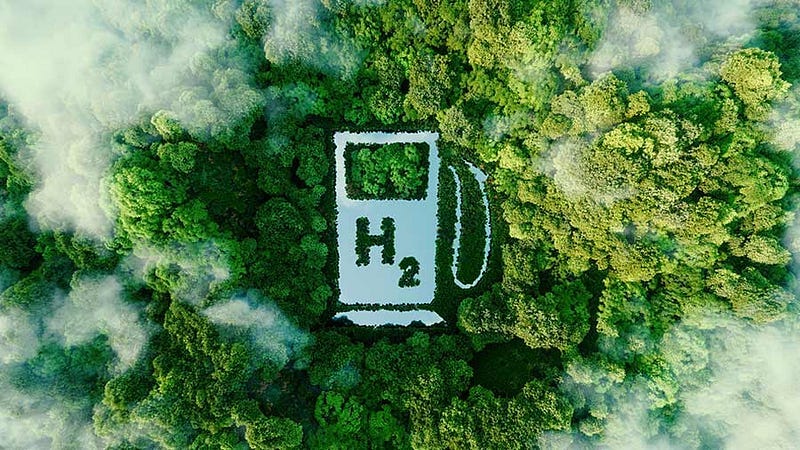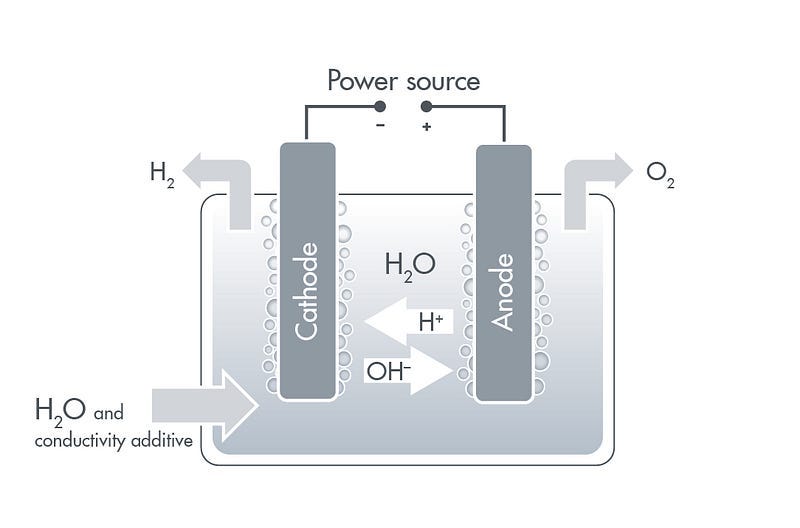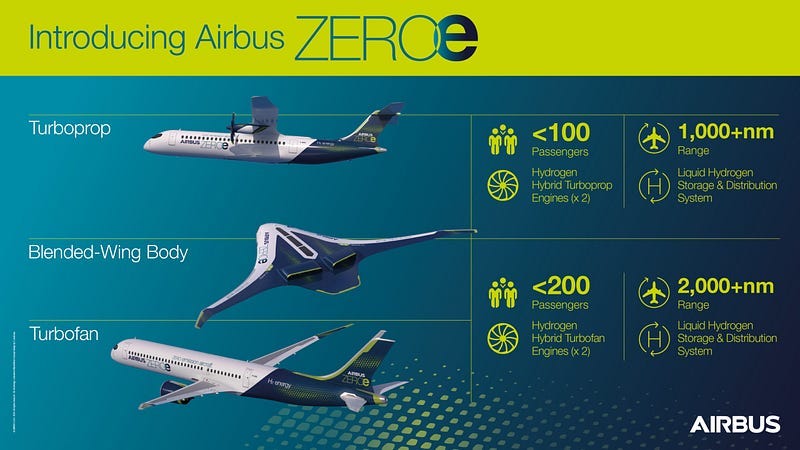Green Hydrogen — The Answer To Effectively Eradicate Fossil Fuels For Our Energy Needs
Let’s go back to school again, for a moment. It’s science class, or specifically, chemistry class, and we’re working on Electrolysis. It’s…
Let’s go back to school again, for a moment. It’s science class, or specifically, chemistry class, and we’re working on Electrolysis. It’s a simple apparatus — salt water, a battery, and two electrodes.
And voila, we split water into the separate molecules Hydrogen(H2) and Oxygen(O2)
This is an electrolyzer, and it’s the future of our power needs.
Every fourteen year old, around the world, has, at some point, performed this experiment, and so we needn't look farther than from our days in school from yesteryear when it comes to the next evolution of creating clean energy.
“The reaction you witnessed then is a key to tackling climate change. Yes, at 14 years old, we already knew. And today, we have the means to replace fossil fuels with green hydrogen.”
“The experiment I’m alluding to is called water electrolysis. And it is a way to create hydrogen. On Earth, hydrogen is found in the greatest quantities in water: H2O. And when you use renewable electricity to split water into H and O, that’s green hydrogen. And the device creating this reaction is called an electrolyzer.”
“There are other colors of hydrogen out there, but they use fossil fuels. So we’re not going to talk about those today, they’ll only make climate change worse. We are talking about green hydrogen, which is 100 percent clean. And the quickest path to scaling green hydrogen is by mass producing electrolyzers,” says Vaitea Cowan.
However, when it comes to the world’s energy needs, on a fundamental level, our energy needs are powered by molecules & not electricity or electrons.
“Why do we need green hydrogen? When we look at our global energy consumption today, only 20 percent comes in the form of electricity or electrons.”
“This means the remaining 80 percent of our world’s energy use is in the forms of molecules. And while the world is making rapid progress in greening our electricity, we need to look towards our molecules as well. Think about your industry, transport, heating and cooling sectors.”
“They’re all powered by molecules. And yes, this means largely by fossil fuels: coal, oil and gas.”
To illustrate how on a fundamental level, molecules create our global energy needs, Cowan explains it with the example of the industrial sector.
“We won’t be able to electrify all of our sectors. And here’s why. Let’s start with an example from the industrial sector. Molecules create the reaction, not electrons.”
“To make steel the old way we first mine iron ore, then burn coal to remove the oxygen from the iron mix. Seven to nine percent of our world’s CO2 emissions come from this process. It’s the coal that provides the molecule, creating the reaction to get rid of the oxygen.”
“Electrons can’t do that. But what they can do is power the device that creates green hydrogen. And this clean molecule will create the reaction, attract the oxygen and emit only water in the process.”
“So by changing the process, we can eliminate up to 95 percent of our CO2 emissions. And today, major European steel manufacturers are already building green hydrogen-based steel production processes.”
When it comes to the aviation sector, in the not so distant future, we can’t rely on batteries to fly planes. However, aircrafts can be fueled by hydrogen as compared to burning fossil fuels.
“Another example, let’s say, that we can’t use electricity for everything-everything is weight. Take the aviation sector. An 80-passenger aircraft flying on batteries. Kind of impossible. One would need more batteries just to fly the battery.”
“Hydrogen planes, though, they’re taking off emission-free. This is a 20-seater aircraft(shows an image of one), and its commercial flights are scheduled two years from now. And by 2026, we’ll be welcoming the 80-seater. And these are just two examples of how we can end our reliance on fossil fuels.”
The Airbus ZeroE is just one more example of a hydrogen-powered airplane.
The applications of green hydrogen are also plentiful and can be used across sectors for our energy needs. By tapping into the versatility of the hydrogen molecule, and by creating green hydrogen, we can take care of our energy needs in several sectors; that’s the future.
“The world is turning to green hydrogen because it is effectively coupling those hard-to-decarbonize sectors with green electricity.”
“An electrolyzer connected to solar and wind power generation is transforming green electrons into green molecules. Green hydrogen is transforming our renewable electricity into an energy carrier that is extremely versatile.”
“And today, this clean molecule is already being used in a wide range of applications. It can be combusted directly as a fuel and emits zero carbon emissions. It’s also being turned into hydrogen-derived fuels like green ammonia, green methanol, which can fuel global shipping.”
However, what makes Cowan’s process of tackling this issue stand apart in producing green hydrogen is that her company Enapter has done intensive economical research, which reveals that mass production & wide usage of electrolyzers by commoditization of it, i.e to make it small enough and cheap and usable enough by people around the world irrespective of the use case, is the best way to disrupt the hold fossil fuels have on our energy needs.
Instead of creating large and enormous electrolyzers, her company is trying to make smaller, more robust and usable electrolyzers so that we can gradually shift away from cheaper fossil fuels commodities like coal, oil and gas.
“We started Enapter in 2017 with this one goal in mind and urgency in our hearts. And so we chose a means that is a bit different from how others in the industry proceed. We turned to economic history for approaches that scaled fast and reduced prices significantly.”
“And the answer was clear. If you want to take a solution around the globe as quickly as possible, you need to make it a standardized, mass-produced commodity. A product that’s easy to make and use. And so some believe we need larger machines. But we believe the electrolyser should be a standardized, mass-produced commodity. A product that can make green hydrogen anywhere for anyone.”
She uses the analogy of using supercomputers vs PCs and laptops, and how the smaller packaged PC & later laptops became the norm and most widely accepted and used form of the computer, after its invention.
“To this end, Enapter is designing all of its electrolyzers as products and not projects. At the heart of our electrolyser is an electrolysis core generating green hydrogen, and it is the foundation for all of our products. And we’re taking these core stacks and other components of our electrolyzers into mass production.”
“And so instead of building larger electrolyzers, we’re building compact ones that can be combined to achieving any hydrogen quantity needed. And we believe this is the quickest way to scale green hydrogen and drive down its price.”
“And the next step is going into mass production. This is our campus. And it’s going to be fully powered by renewables, of course, and that’s where we’ll be tackling speed, scale and cost. By focusing on one single core size, we can leverage massive economies of scale and drive down the price of green hydrogen.”
“This is how we end the fossil fuel era.” — Vaitea Cowan
In her TED Talk, social entrepreneur Vaitea Cowan, explores green hydrogen from the most basic school experiment, to how it is going to change the very fabric of our energy needs in the future.
It could usher in a new era of powering all our energy needs, in a 100% clean way, and slowly but surely, end our usage of cheap fossil fuels.







